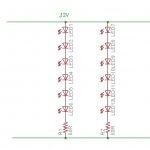Hello again, I'm still around here everyday and I been learning a bunch from you guys, THANKS for the help! This time I'm working on an array of 14 IR LEDs. Yes, I'll certainly be using a Picaxe to control the array...on at night... not used during the daytime. It's going to be in another RF video cam for watching critters.
I'm intending on using a 317T as a current regulator, using a 12 volt battery for power. The LEDs will be running around 250ma...rated for 350ma. Now these are not the best in the world, and the quality control is lacking some, so they are not matched real well
My question is: which way of wiring the things together, and using a current regulator, would keep the current the most even between all the LEDs??? 14 is all that will fit inside the enclosure is why I'm using that number I hope I drew this right...it's late and I'm tired. Thanks!
I hope I drew this right...it's late and I'm tired. Thanks!
EDIT: Assume I'm color blind OK...duh...I'll get them right when I use real ones
I'm intending on using a 317T as a current regulator, using a 12 volt battery for power. The LEDs will be running around 250ma...rated for 350ma. Now these are not the best in the world, and the quality control is lacking some, so they are not matched real well
My question is: which way of wiring the things together, and using a current regulator, would keep the current the most even between all the LEDs??? 14 is all that will fit inside the enclosure is why I'm using that number
EDIT: Assume I'm color blind OK...duh...I'll get them right when I use real ones
Attachments
-
43.2 KB Views: 67
Last edited:





